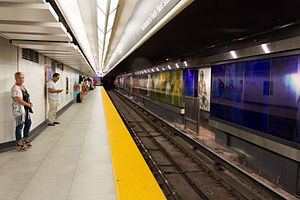Platforms 2 side platforms Disabled access Yes Passengers (2014) 125,220 | Structure type underground Rebuilt 2011-2015 Opened 30 March 1954 | |
 | ||
Location 55 Front Street West,
Toronto, Ontario
Canada Connections Union Station, Union Station Bus Terminal Similar Union Station, Spadina, Downsview, St Andrew, Eglinton West | ||
Union is a rapid transit station on Line 1 Yonge–University of the Toronto subway and RT in Toronto, Ontario, Canada. It opened in 1954 as one of twelve original stations on the city's first section of subway. The station is also terminus of the 509 Harbourfront and 510 Spadina streetcar routes.
Contents
- Entrances
- History
- Station expansion
- Station decor
- Subway infrastructure
- Nearby landmarks
- Surface connections
- References
Union Station is located on Front Street between the Yonge Street and University Avenue sections of the line. It directly connected to the railway station and regional bus terminal of the same name. Based on Toronto's street grid, Union is the southernmost subway station; however, using standard compass directions, Kipling and Islington Stations are further south.
Union connects the subway with GO Transit, Via Rail, Union Pearson Express trains, and GO Transit buses. It serves approximately 100,000 people a day, ranking it as the fourth-busiest station in the system, after Bloor-Yonge, St. George & Sheppard–Yonge and the system's busiest station served by only one line. Wi-fi service is available at this station.
Entrances
North side entrances:
South side entrances:
History
The station opened as the southern terminus of the original Yonge subway line on March 30, 1954.
On February 28, 1963, Union became a through station with the opening of the University section of the Yonge–University line.
On June 22, 1990, Union became the terminus of route 604 Harbourfront LRT, now part of the 509 Harbourfront and 510 Spadina streetcar routes. A new underground streetcar platform was built south of the subway tracks, connected to the station concourse by a 30-metre pedestrian tunnel and a flight of stairs.
Elevators were installed in 1996, making Union one of the first wheelchair-accessible subway stations in Toronto. An elevator was added to the streetcar platforms, even though streetcars were not accessible themselves. By the time accessible streetcars began serving the station in 2014, the elevator had been replaced as a part of the station expansion.
On August 18, 2014, a second subway platform was opened to serve Yonge line trains, leaving the existing platform to serve only University line trains.
Flexity Outlook streetcars started to serve Union from route 510 Spadina on October 12, 2014, and from route 509 Harbourfront on March 29, 2015. As a result, passengers are now required to have Proof-of-payment (POP) to depart Union by streetcar.
Station expansion
In 2003, planning began on a station expansion to address overcrowding in the station. Despite being one of the busiest stations in the system, the station had only one narrow island platform serving both the University and Yonge lines, and a small concourse area.
The resulting plan was to build a new subway platform on the south side of the tracks to serve the Yonge line, leaving the existing island platform to serve only the University line. This new platform would feature a level connection to the streetcar platform. The project also included significantly expanding the concourse level and replacing all finishes.
Preparatory work began in 2006, and construction began in February 2011. The new second platform opened on August 18, 2014.
Station decor
When the station opened in 1954, the wall coverings were glossy yellow Vitrolite tiles with red lettering and trim, and the station name on the walls was in the TTC’s unique Toronto Subway Font.
During renovations in the 1980s, the yellow vitrolite tiles were replaced with brown ceramic tiles and vinyl siding and the station font was changed to Univers.
The 2011-2015 station expansion replaced these tiles and panels with white tiles and black trim, and the station name was returned to its original Toronto Subway typeface.
As part of the second platform project, a glass wall was built to block off the southern side of the old platform since it now only serves the University line. It features the art piece "Zones of Immersion" by Stuart Reid, a professor at the OCAD University The work comprises 166 large glass panels, each measuring more than one by two metres, extending 170-metre (560 ft) along the length of the platform. Mostly transparent, it is visible from both the Yonge and University platforms. Each panel contains images or words, many based on sketches that Reid drew while riding the subway.
Subway infrastructure
Leaving the station eastbound, the Yonge leg of the line runs briefly under Front Street and turns 90 degrees north to run under Yonge Street; leaving westbound, the University leg also runs under Front Street, and eventually turns 90 degrees north to run under University Avenue.
This station is one of the only stations that has a curved platform (the other one being St Clair station).
The station is also noted as being one of only three stations on the TTC where a signal light is publicly accessible (the others being Davisville and Islington Station). The signal is located on the east (trailing) end of the University line platform. It is an interlocking signal that protects the crossover to the northbound Yonge Line and is only occasionally used to reverse Yonge Line trains at Union.
Nearby landmarks
Nearby landmarks include Union Station, the Royal York Hotel, the Air Canada Centre, Rogers Centre, the Metro Toronto Convention Centre, the CN Tower, the Royal Bank Plaza, Brookfield Place, the Hockey Hall of Fame, and the Sony Centre for the Performing Arts.
Surface connections
A direct connection between the subway and streetcars within the fare-paid zone is provided for these routes:
A transfer is required to connect between the subway or streetcars and these bus routes at curbside stops:
